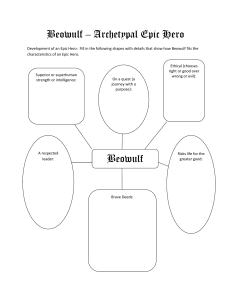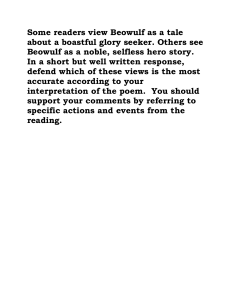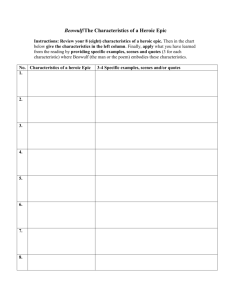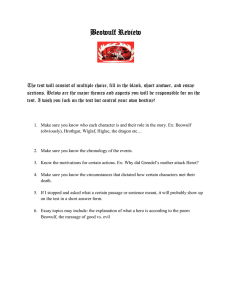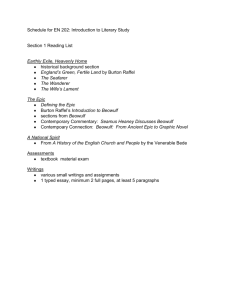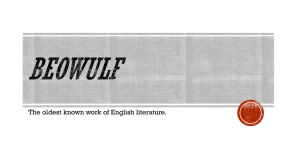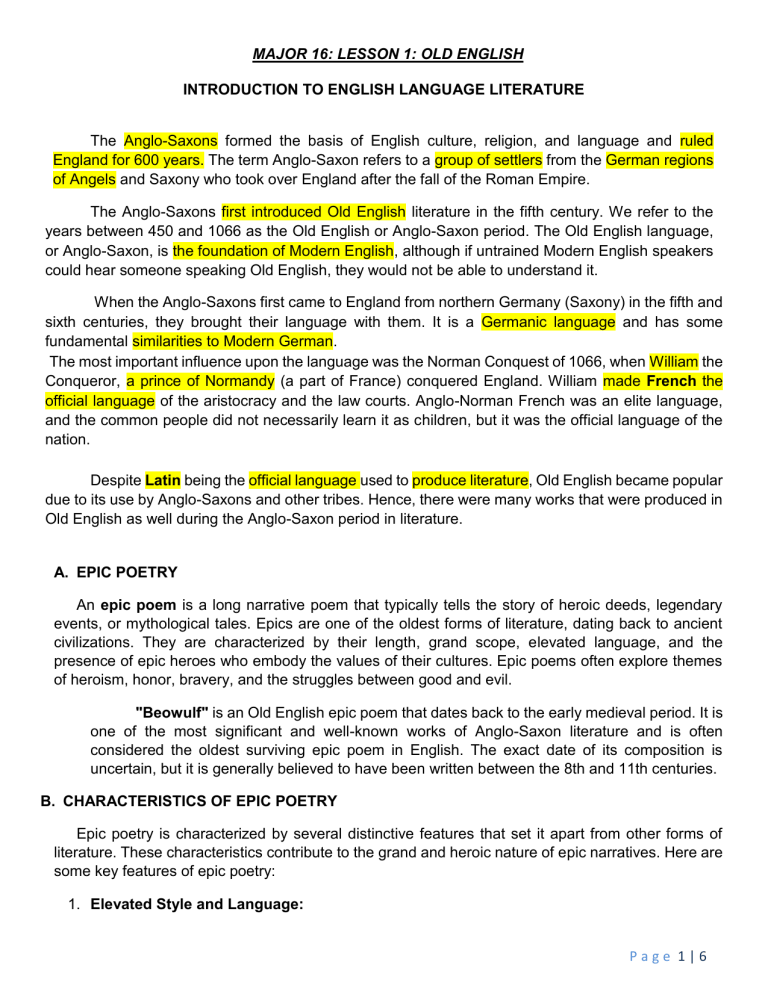
MAJOR 16: LESSON 1: OLD ENGLISH INTRODUCTION TO ENGLISH LANGUAGE LITERATURE The Anglo-Saxons formed the basis of English culture, religion, and language and ruled England for 600 years. The term Anglo-Saxon refers to a group of settlers from the German regions of Angels and Saxony who took over England after the fall of the Roman Empire. The Anglo-Saxons first introduced Old English literature in the fifth century. We refer to the years between 450 and 1066 as the Old English or Anglo-Saxon period. The Old English language, or Anglo-Saxon, is the foundation of Modern English, although if untrained Modern English speakers could hear someone speaking Old English, they would not be able to understand it. When the Anglo-Saxons first came to England from northern Germany (Saxony) in the fifth and sixth centuries, they brought their language with them. It is a Germanic language and has some fundamental similarities to Modern German. The most important influence upon the language was the Norman Conquest of 1066, when William the Conqueror, a prince of Normandy (a part of France) conquered England. William made French the official language of the aristocracy and the law courts. Anglo-Norman French was an elite language, and the common people did not necessarily learn it as children, but it was the official language of the nation. Despite Latin being the official language used to produce literature, Old English became popular due to its use by Anglo-Saxons and other tribes. Hence, there were many works that were produced in Old English as well during the Anglo-Saxon period in literature. A. EPIC POETRY An epic poem is a long narrative poem that typically tells the story of heroic deeds, legendary events, or mythological tales. Epics are one of the oldest forms of literature, dating back to ancient civilizations. They are characterized by their length, grand scope, elevated language, and the presence of epic heroes who embody the values of their cultures. Epic poems often explore themes of heroism, honor, bravery, and the struggles between good and evil. "Beowulf" is an Old English epic poem that dates back to the early medieval period. It is one of the most significant and well-known works of Anglo-Saxon literature and is often considered the oldest surviving epic poem in English. The exact date of its composition is uncertain, but it is generally believed to have been written between the 8th and 11th centuries. B. CHARACTERISTICS OF EPIC POETRY Epic poetry is characterized by several distinctive features that set it apart from other forms of literature. These characteristics contribute to the grand and heroic nature of epic narratives. Here are some key features of epic poetry: 1. Elevated Style and Language: Page 1|6 MAJOR 16: LESSON 1: OLD ENGLISH Epic poetry is known for its formal and elevated style. The language used is often grandiose and more complex than everyday speech. Poets employ poetic devices such as metaphors, similes, and elaborate descriptions to enhance the narrative. 2. Heroic Protagonist (Epic Hero): The epic hero is a central figure in the narrative, typically possessing exceptional qualities such as courage, strength, intelligence, and nobility. The hero embarks on a significant quest or journey, facing challenges and adversaries. 3. Supernatural Elements: Epics often incorporate supernatural elements, including gods, goddesses, mythical creatures, and divine interventions. These elements add a mythical or legendary dimension to the story, emphasizing the hero's connection to the divine. 4. Majestic Setting: Epic poems are set on a grand scale, covering vast geographic locations and featuring epic battles, heroic quests, and legendary landscapes. The setting often includes both the mortal world and the realm of the divine. 5. Invocation to the Muse: Many epic poems begin with an invocation to a muse or deity, seeking inspiration and guidance for the poet. This convention underscores the cultural and artistic significance of the epic. 6. Epic Conventions: Epics often adhere to specific conventions, such as the use of formal epithets (repeated descriptive phrases), cataloging (listing of characters, objects, or events), and extended similes that elaborate on comparisons. 7. Long Narrative: Epic poems are lengthy narratives, often consisting of multiple books or cantos. The length allows for the comprehensive exploration of the hero's journey, adventures, and the cultural and historical context of the narrative. 8. Moral and Cultural Values: Epics convey the moral and cultural values of the society in which they were composed. The hero's actions and challenges reflect the ideals and beliefs of the culture, providing both entertainment and moral guidance. Page 2|6 MAJOR 16: LESSON 1: OLD ENGLISH 9. Epic Similes (Homeric Similes): Epic poems often feature extended similes, also known as epic similes or Homeric similes. These are elaborate comparisons that extend over several lines, enriching the descriptive elements of the narrative. 10. Themes of Fate and Destiny: Epic poetry frequently explores themes of fate and destiny. The hero's journey is often influenced by prophetic visions or divine decrees, highlighting the inevitability of certain events. Examples of epic poems that embody these characteristics include "The Iliad" and "The Odyssey" by Homer, "The Aeneid" by Virgil, and "Beowulf," an Old English epic. These characteristics collectively contribute to the enduring appeal and cultural significance of epic poetry across different societies and historical periods. C. HISTORICAL BACKGROUND OF BEOWULF "Beowulf" is an Old English epic poem that provides a glimpse into the early medieval period in England. While the exact date of its composition is uncertain, scholars generally believe that it was written between the 8th and 11th centuries. The poem is one of the most significant works of AngloSaxon literature and is considered the oldest surviving epic poem in English. Here is a brief overview of the historical background of "Beowulf": Anglo-Saxon England: 1. Migration Period (4th-7th centuries): The Germanic tribes, including the Angles, Saxons, and Jutes, migrated to England during the Migration Period, leading to the establishment of Anglo-Saxon kingdoms. 2. Anglo-Saxon England (5th-11th centuries): The period of Anglo-Saxon England was characterized by a complex network of competing kingdoms. The Anglo-Saxons were pagans before the widespread conversion to Christianity, which began in the 6th and 7th centuries. Cultural Context: 1. Oral Tradition: Before the advent of writing, much of Anglo-Saxon literature, including "Beowulf," was part of the oral tradition. Poets (scops) would recite and perform these epic poems in the courts of kings and nobles, passing down stories from one generation to the next. Page 3|6 MAJOR 16: LESSON 1: OLD ENGLISH 2. Heroic Values: The society depicted in "Beowulf" reflects the heroic values of the Anglo-Saxons. These values include bravery, loyalty, honor, and the pursuit of glory in battle. The poem offers insights into the cultural norms and ideals of the time. BEOWULF JOURNEY Beowulf's journey, as depicted in the Old English epic poem "Beowulf," is a series of heroic exploits that showcase the protagonist's courage, strength, and sense of duty. The narrative follows Beowulf from his arrival in Denmark to his eventual death as the king of the Geats. Here is an overview of Beowulf's journey: 1. 2. 3. 4. Part 1: The Arrival in Denmark Call to Adventure: Beowulf, a warrior of the Geats, hears of the troubles in the kingdom of the Danes. The mighty monster Grendel is terrorizing King Hrothgar's hall, Heorot. Departure: Beowulf, seeking glory and fame, decides to sail to Denmark with a group of his warriors to offer his assistance to King Hrothgar. Arrival in Heorot: Beowulf and his men arrive in Denmark and are welcomed by the Danes. Beowulf introduces himself and expresses his intention to face Grendel. Battle with Grendel: Beowulf engages in a fierce hand-to-hand combat with Grendel in Heorot. He succeeds in ripping off Grendel's arm, mortally wounding the monster. Part 2: Confrontation with Grendel's Mother 1. Retribution: Grendel's mother seeks revenge for her son's death and attacks Heorot. Beowulf decides to confront her and travels to her underwater lair. 2. Battle with Grendel's Mother: Beowulf descends into the underwater cave and engages in a fierce battle with Grendel's mother. After a struggle, he manages to defeat her with a magical sword, forged by giants. Page 4|6 MAJOR 16: LESSON 1: OLD ENGLISH Part 3: Return to Geatland 1. Triumphant Return: Beowulf returns to Geatland, and his exploits earn him praise and admiration. He becomes a hero and is welcomed by his uncle, King Hygelac. 2. Gifts and Honors: Beowulf presents the treasures he received from Hrothgar as gifts to King Hygelac. He is rewarded with further honors and is considered a great leader among the Geats. Part 4: Reign as the King of the Geats 1. Succession to the Throne: After King Hygelac's death, Beowulf becomes the king of the Geats. He rules wisely and maintains peace in his kingdom for several years. 2. The Dragon Threat: In Beowulf's old age, a dragon is awakened, and its wrath threatens the Geats. Beowulf, still eager for glory, decides to confront the dragon. Part 5: The Final Battle 1. Battle with the Dragon: Beowulf, accompanied by a few loyal warriors, faces the dragon. Despite initial success, the dragon's fiery breath severely wounds Beowulf. 2. Death of Beowulf: In the final moments of the battle, Beowulf delivers a fatal blow to the dragon, but he himself is mortally wounded. Sensing his impending death, Beowulf appoints Wiglaf as his successor and passes away. Conclusion: Legacy and Mourning 1. Funeral Rites: Beowulf's body is cremated, and his funeral is a grand affair, symbolizing the end of an era. His heroic deeds and sacrifice are celebrated by the Geats. 2. Legacy: Beowulf leaves behind a legacy of heroism and leadership. His story is told and retold, ensuring that his name and deeds will be remembered for generations. Beowulf's journey is a classic representation of the hero's quest, marked by bravery, loyalty, and the pursuit of glory. The narrative explores themes of heroism, mortality, and the inevitable passage of time. Lesson: The story of Beowulf imparts the lesson that true heroism lies in facing challenges with unwavering courage, even in the face of mortality. It emphasizes the importance of loyalty, honor, and self-sacrifice for the greater good. Beowulf's legacy Page 5|6 MAJOR 16: LESSON 1: OLD ENGLISH teaches that deeds of valor and integrity leave a lasting impact, emphasizing the value of leading with wisdom and leaving behind a legacy of virtue. The narrative prompts reflection on the transient nature of life and the enduring significance of one's actions. Activity 1: A. Directions: Based on “Beowulf”, what are the characteristics possessed by a hero? Complete the diagram below. HERO B. Grendel's mother's actions are often driven by maternal instincts to protect her son. How did the theme of motherhood influence your emotional response to her character? C. What do the characters of Grendel, Grendel's mother, and the dragon symbolize in the context of the struggle between good and evil? Page 6|6
